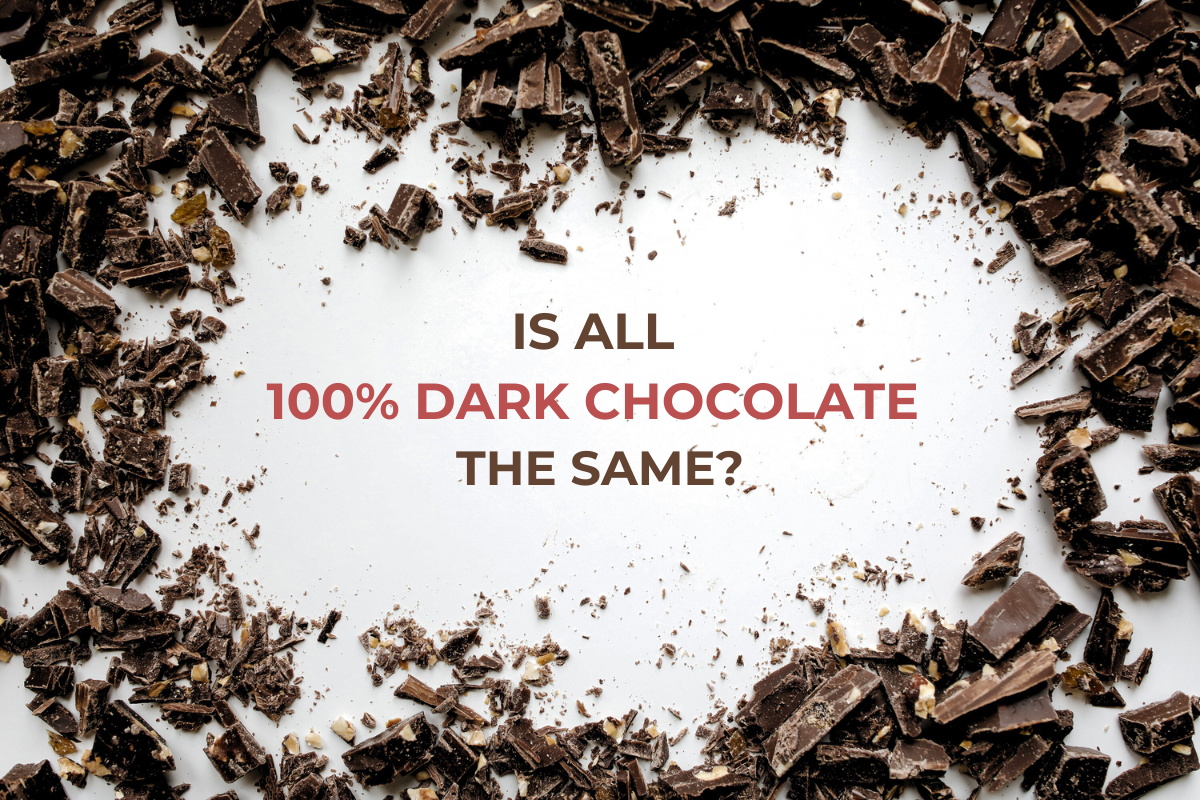Hey there, chocolate lovers! We’ve got an interesting question for you: Is ALL 100% DARK CHOCOLATE THE SAME? We aren’t talking about the difference between cocoa from one country or another, but rather the core composition of the chocolate. It’s 100%, so how much can it differ, right? Well, if you’re curious to find out if 100% dark chocolate is all the same, then keep reading! We’re about to spill the cocoa beans and uncover the truth.
What does 100% dark chocolate mean?
“100% dark chocolate” is chocolate crafted exclusively from cocoa. It contains no added sugar and is derived solely from cocoa beans. While some manufacturers may incorporate a small amount of lecithin, they must maintain the chocolate’s cocoa content at a minimum of 99.75% by volume.
Additionally, while most 100% dark chocolates are plain, some may have added flavors or inclusions such as cocoa nibs. Usually, additional ingredients like nuts, berries, salt, or herbs are added separately and are not integrated into the chocolate itself, ensuring that the chocolate remains 100% dark. Most often these variations are still marked as 100% dark chocolate with inclusions because the core chocolate is still made without sugar.
If a chocolate contains alternative sugars like stevia, xylitol, or monk fruit extract, it cannot be labeled as 100% dark chocolate, even if it’s marketed as sugar-free chocolate.
Are all 100% dark chocolate bars the same?
In simple terms, no. When we talk about the cocoa percentage in chocolate, it includes any cocoa-derived products like cocoa nibs, cocoa powder, and cocoa butter (cocoa beans are comprised of ~50% fat, which is the cocoa butter, and ~50% cocoa solids, which is cocoa powder). Since cocoa butter and cocoa powder are derived from cocoa beans, they still abide by the 100% rule, regardless of their inclusion or exclusion. This means that while one 100% dark chocolate bar might be made from 100% cocoa beans, another might have cocoa beans plus extra cocoa butter. Both are labeled as 100% dark chocolate, but they’ll taste very different. To know what you’re getting, always check the label to see if your 100% dark chocolate has added cocoa butter (or cocoa solids). It’s not a problem if it has added cocoa butter, but it does mean there’s more fat in it.
Impact of cocoa bean origin
While the origin of the beans may differ from bar to bar, it doesn’t impact the 100% dark designation. However, the flavor of chocolate will be influenced by where the cocoa beans are sourced. Different regions produce cocoa beans with distinct flavor profiles, influenced by factors such as soil, climate, and farming practices. The cacao varietal and climate may also impact the fat content of the beans which can also impact flavor and texture.
Chocolate processing techniques and their effects
The way cocoa beans are processed can certainly affect the taste and texture of the chocolate. Variations in roasting, grinding, and conching can lead to differences in flavor intensity, smoothness, and mouthfeel. A 100% dark chocolate bar that is processed and conched for five days rather than two days will have a different flavor and texture. It’s the job of the chocolate maker to tune all the processing parameters to produce the best tasting chocolate from the selected beans. And while it would seem that producing a 100% dark chocolate bar would be quite limiting, the reality is that there are many ways to fine tune the chocolate.
Choosing the right 100% dark chocolate
When choosing the perfect 100% dark chocolate for you, start by checking the ingredient list. Ensure it contains only the ingredients you want, without any added sugars, sweeteners, or artificial ingredients (it shouldn’t, if it’s a true 100% dark chocolate bar!).
Consider the origin of the cocoa beans, as that can greatly influence the flavor profile of the chocolate; exploring chocolates sourced from different regions will allow you to discover your preferred taste.
Take note of the texture and mouthfeel, as some 100% dark chocolates may include additional cocoa butter or lecithin for a different consistency, offering a choice between creamier or more intense chocolate experiences. Conduct taste tests whenever possible, sampling various brands or varieties to find the one that best suits your palate.
While price doesn’t always reflect quality, consider purchasing higher-quality chocolate bars made from ethically sourced cocoa beans to support sustainable and fair-trade practices, which can enhance your overall chocolate experience.
Don’t miss our article ”what does % cocoa mean on chocolate bars” If you want to learn more about how percentages are calculated. Understanding the percentages of cocoa solids and cocoa butter listed on chocolate labels can give you valuable insights into the chocolate’s composition and quality.
For more great articles and recipes, check out the rest of our CocoTerra blog.
If you have any questions or comments, feel free to contact us through our social media channels. We are @cocoterra_co on Instagram and Pinterest and @cocoterraco on X (aka Twitter) and Facebook.








